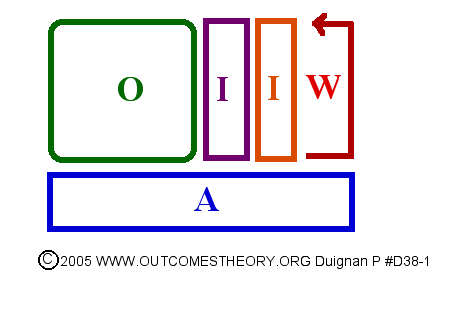There are five fundamental building blocks which lie beneath any outcomes system. In the case of any specific outcomes system these building blocks may or may not have been made explicit. The building blocks can be summarized by the acronym OIIWA and are set out in the OIIWA schematic below.

The five building blocks are as follows:
O – an outcomes hierarchy. This is the set of outcomes from highest-level outcomes right at the top down through each level of outcomes which are their causes, to very low level outcomes right at the bottom of the hierarchy. These hierarchies are best viewed as a "cascading set of causes in the real world". An intervention within such a hierarchy should be viewed as one or more low-level outcomes that are produced (or changed) in order to bring about changes all the way up the outcomes hierarchy until finally the highest-level outcomes are influenced in the desired direction [1][2].
I[n-att] – not-necessarily attributable indicators. This is the set of routinely collected indicators measuring change in outcomes throughout the outcomes hierarchy. The mere measurement of change in any outcome using this type of indicator does not necessarily mean that the change can be attributed to a particular intervention. In any outcomes system there may or may not be one or more not-necessarily attributable indicators for a particular outcome. These indicators let the user track progress in achieving the outcomes in the outcomes hierarchy without necessarily being able to say whether or not the intervention caused them.
I[att] – attributable indicators. This is the set of routinely collected indicators measuring change in outcomes throughout the outcomes hierarchy for which changes in the outcome can be attributed to a particular intervention. This set of indicators is a subset of the set of not-necessarily attributable indicators. There can be as many sets of not-necessarily attributable indicators for any outcomes hierarchy as there have been defined discrete interventions (i.e. sets of one or more lower level outcomes). In any outcomes system, there may or may not be one or more attributable indicators for a particular outcome. In many outcomes systems these attributable indicators do not reach as high up the outcomes hierarchy as not-necessarily attributable indicators.
W – Whole-intervention outcome attribution evaluation designs. These are evaluation designs (or outcome experiments) [3] that allow claims to be made about attribution of changes in high-level outcomes to a particular intervention. The process of making these claims differs from that of the claim of attribution made in regard to attributable indicators. Attributable indicators are routinely collected measures which are such that their mere collection is sufficient for changes in them to be accepted as attributable to an intervention. There are a limited number of possible whole intervention outcome attribution evaluation designs. In the case of any particular outcomes system these designs may be feasible and/or affordable or neither feasible nor affordable.
A – Answering additional lower-level evaluation and research questions. This is a set of evaluation and research questions which provide additional information about aspects of the outcomes hierarchy but which do not provide the type of overall claim about attribution of changes in high-level outcomes yielded by the whole intervention outcome attribution evaluation designs. These evaluation questions are often called formative or process evaluation questions as contrasted with outcome evaluation questions (dealt with in building block W above).
Notes:
[1] In order to increase accessibility, this knowledge base uses the term outcomes (rather than the outcomes theory technical term causal entity) to mean any "cause in the real world." This is done in full awareness that a rigid distinction is sometimes made in outcomes systems thinking between outcomes and outputs and this distinction is portrayed in outcomes hierarchies. Outcomes theory reveals when it does, and when it does not, make sense to distinguish between entities such as outputs and outcomes on the basis of the formal logical characteristics of the entities known as outcomes and outputs. However the most conceptually parsimonious way of viewing what is being included in an outcomes hierarchy is that it is a "cascading set of causes in the real world", finer distinctions between the causal entities in such hierarchies are made at a later stage within outcomes theory.
[2] Outcomes hierarchies are a subset of what are also known as: intervention logics, results chains, causal maps, program theories.
[3] There is continuing debate in the evaluation, public policy, evidence-based practice and other research literatures about exactly which types of designs will provide robust evidence of whole intervention outcomes attribution. Some argue that only a narrow set of experimental and certain quasi-experimental designs should be accepted as doing this. Others argue for accepting a wider set of designs in those cases where they provide attributional claims which are acceptable by a community of users. From the point of view of outcomes theory, it does not matter exactly which of the designs a particular community of users find acceptable. From a conceptual point of view outcomes theory only requires that a distinction be made between those designs that can provide a community of users with what they regard as robust evidence of causality and those which do not.
V1-0.
